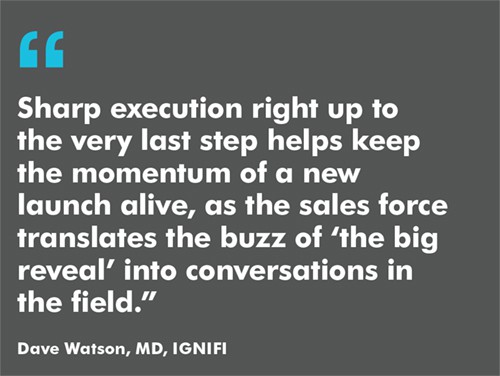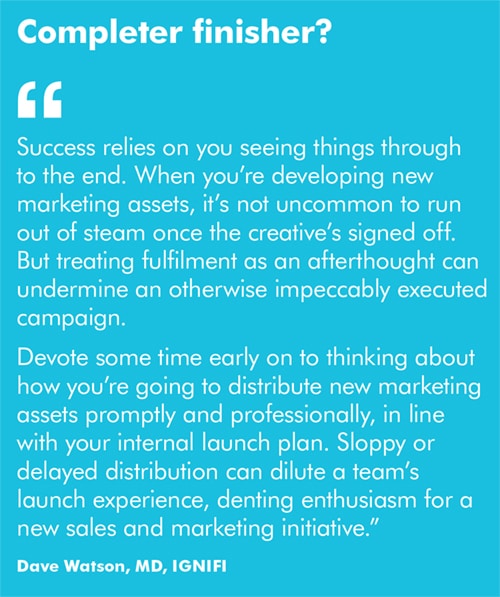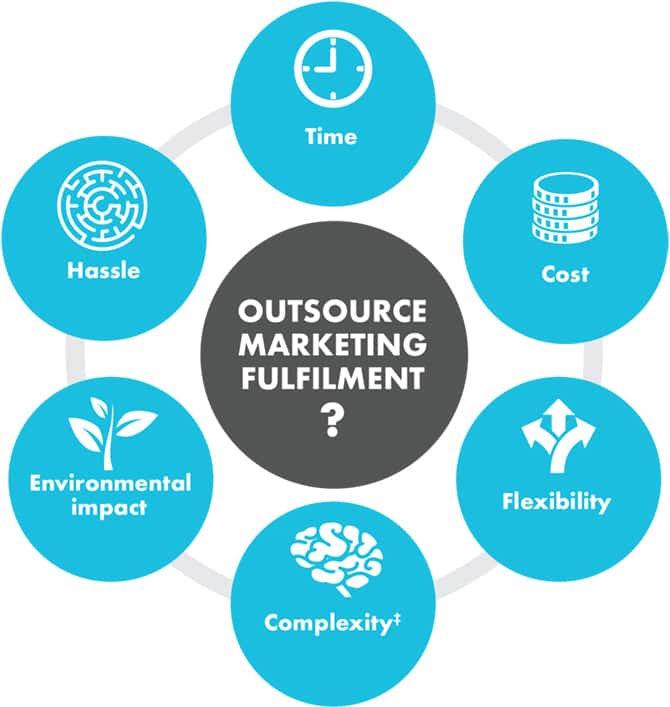WHITE PAPER: Marketing fulfilment – a balancing act
January 27, 2020 | Print, distribution, fulfilment, logistics, marketing efficiency, marketing materials, working smarter
A guide to super-charging this ‘make or break’ element of your marketing function
Marketing fulfilment – a balancing act

The pursuit of efficiencies, the drive towards continuous improvement and the renewed onus on ROI aren’t challenges exclusive to marketers in health and pharma, but there’s no denying the whole host of factors that put these communicators under more pressure than most.
With the age of blockbuster drugs likely behind us and health authorities standing their ground on pricing,1 innovation is riskier and more costly than before.2 As a result, you’d struggle to find a marketing budget holder immune to the culture of achieving more with less or honing lean working practices.
What’s the upshot of this tougher marketing climate?
Sing for your supper
When it comes to sales force effectiveness, the stakes are higher than ever. The pressure is on the sales force to maintain a healthy sales pipeline and marketers can’t afford to let the side down. Getting the right communications tools developed, localised, approved and promptly delivered to the sales team is absolutely crucial.

When is a saving not a saving?
Decisions as to what to outsource and what to tackle in-house are more closely scrutinised, often with input from procurement, in a mission to maximise value. For everything from social media to creative, the temptation is to in-source by plugging in apprentices, new hires, help from other departments or junior members of staff. But there’s a bigger picture exercise to be done here, around which marketing activities are genuinely more efficient done in-house. One function that often comes up in this in-vs-outsourcing debate is fulfilment (see The right fit, page 6) – the final but critical link in the marketing chain that sees finished assets distributed to the sales front line.

Fulfilment is sometimes undervalued as it’s resource-intensive and doesn’t attract the glory of coming up with a headline campaign message or developing new creative. Equally, it can be neglected; by the time a marketing team’s had new marketing collateral approved after months of hard work, they can (understandably) run out of steam and fall short of dotting the last of those i’s and crossing the final t’s. But like it or not, fulfilment can make or break your campaign (see The Good, the Bad & the Stressful).
Alongside being a creative partner to major pharma, healthcare and active lifestyle brands, for many years, clients like Nike and P&G have relied on IGNIFI for specialist fulfilment support to enhance the way they deliver their marketing programmes. With that experience under our belt, here are some ideas that might get you thinking about how you could streamline the way you manage fulfilment.
1. Do you need to be the middle man?
Whether you’re managing the logistics of printing, storing, packing and distributing marketing assets in-house or using an external handler, are you more involved in the fulfilment process than you need to be?
If you’re handling things in house…
Up-front input
Could more guidance for staff free you from some of the routine elements (and hiccups) of managing marketing assets?
* Creating a checklist or sign off sheet specific to individual territories or events might save you from checking all the boxes have been ticked before other members of your team distribute assets.
* Things often come unstuck when assets are delivered to conferences without the correct event-specific paperwork. Link to all the forms and resources in your checklist to avoid materials being quarantined, leaving you high and dry.
* Drawing up a flow chart to show when certain couriers should be used could save you time (and questions) e.g. fastest/most cost-effective courier based on size, location etc.
* Recording delivery preferences for each member of the field sales team can boost internal perception of the marketing function, earn you goodwill with the sales team (who prefer not to repeat themselves or wait in for deliveries) and minimise disruption if the person in charge of fulfilment in your department is off duty.
If you’re working with a fulfilment house…
Are you a bottleneck?
Are you involved in decisions that don’t really need your input? If you have confidence in the company managing your fulfilment, could they deal direct with your sales force? You could agree on the volume, type or value of materials each member of the team can order before your authorisation’s needed; this way, you’re only consulted if agreed order levels are reached. Our fulfilment arm deals direct with individual field-based team members for a number of our clients and they tell us things are faster and simpler as a result.
2. Could you automate more?
If you’re managing your marketing assets in-house, introducing an online ordering system could save you bags of time. Whether off-the-shelf or bespoke, investing time up front on a portal to manage access to digital and printed assets could pay off quickly, giving you better version control and saving time updating colleagues in the field about new assets.
Much like an e-commerce site, it would allow members of the sales force to:
* access only those marketing assets approved for their use, such as sales aids for their market
* download only the current version of digital assets to share with their contacts
* ‘shop’ for sales collateral, ordering printed materials and merchandise online, to be delivered direct to them, with reports/stock updates sent to an appointed person in your department.
Plus:
* print items could automatically be reprinted when stock runs low
* access to assets could be automatically blocked on a pre-agreed expiry date (or if a product is recalled/ rebranded), giving you better version control.

3. Are you working blind (or blinded by information overload)?
If you’re overseeing the marketing function, keeping an eye on where marketing assets are going is just one of the many plates you’re spinning. When it comes to reporting, you need enough information to keep you informed, but you don’t want fulfilment to take up a disproportionately large slice of your (finite) time. Agreeing the right balance could save you precious time and interruptions.
Emails
On average we spend 2.5 hours a day dealing with the 200 emails in our inbox. According to Forbes, 72 per cent of these emails are irrelevant,3 meaning we could gain the equivalent of one working day a week† by deciding which emails we can do without and agreeing just who (if not you) needs to receive what information. Depending on how and who distributes and manages your marketing assets, it can create mounds of (often unnecessary) emails.
If you’re nodding your head in recognition, it’s time to take a long, hard look at your inbox and work out:
* which emails aren’t necessary at all or should go to another member of your team
* if any updates could it be condensed into fewer emails such as a monthly summary
* could you set up filters in your inbox to automatically file emails so you can look at them at a time that suits you.
Once you’ve decided what you can do without, agree these parameters with your team or fulfilment partner, and then turn your attention to reporting.
On average we spend 2.5 HRS dealing with 200 EMAILS (72%) of these are irrelevant3
Reporting
Understanding your fulfilment habits could help you identify sources of savings (both time and cost). Equally, you may be spending time reviewing reports that are a ‘time drain’ and don’t add value.
To help get the balance right, think about the following:
* Are you getting reports on how much each member of your team is ordering per month? And do you need this level (or frequency) of detail?
* Do you know how much you’re spending on last minute couriers vs standard couriers? Having this data at hand could help you identify efficiencies, helping your budget work harder.
* Are you copied in every time half a dozen branded USBs are despatched? (See Emails, left). Tell your team you’re happy for them to get on with it as long as they flag up any major issues.
Agreeing how much information is enough and redrawing the parameters with those managing fulfilment for your brand is one way to help cut out unnecessary and time-consuming ‘noise’.

† 2.5 hours (150 minutes) are spent on email per day, of which 72% (108 minutes per day x 5 working days = 540 minutes or 9 hours per week) are unnecessary.
‡ e.g. what if you need specialists such as refrigerated vans?
4. Are you ready for anything?
How ready are you for a recall? If you’ve got the right process in place, you should be in a position to respond quickly to a recall without too much disruption to normal marketing functions. Test your recall readiness with the following questions:
If a product was recalled tomorrow and you had to withdraw marketing materials from your field-based teams in different territories:
* how long would it take?
* how much time would it take you to coordinate?
* how much stress would it cause you?
* if you were out of the office, would your team know what process to follow?
* could you generate a certificate to confirm what materials were destroyed?
* if not, how could you be sure all team members have sent everything back?
As with any element of crisis management, it’s worth establishing a process for handling marketing collateral in case of a recall. Whether you manage the distribution of marketing assets yourself or through a supplier, agreeing roles and acceptable timeframes (and putting it to the test with a dummy run) will shine a light on any gaps and pay dividends in terms peace of mind.
5. Could you be greener?
Whatever your function within a business, it’s now a given that you’ll do what’s possible to enhance your brand’s reputational capital by acting in an environmentally responsible way. How you manage marketing collateral is an obvious chance to take a green approach and contribute to your brand’s wider corporate CSR agenda.
If you manage marketing fulfilment in-house, you may be very aware of how ‘green’ you are and have more control in choosing more eco-friendly ways to print and distribute marketing assets. If you outsource fulfilment or you’re looking for a future supplier, you might (rightly or wrongly) assume external suppliers are being green in the way they do things. But could you do more? Could you ask more questions and learn more about the green choices you’re making (and be recognised for it internally or create a PR friendly headline as a by-product)?
Things to think (or ask your fulfilment partner) about
Are you:§
* using appropriately sized packaging (not too big)? As well as the environmental cost, you could be spending more than you need to, as couriers charge by volume.
* using recycled materials?
* re-using boxes where possible?
* recycling packaging?
* able to separate more materials to help you recycle more?
* using couriers that care about doing more to reduce environmental impact?
The right fit: choosing the right handling option for you

Pros
*Ability to handle any volume and ship to any location
*Access to specialist services such as large scale assembly and barcoding of stock items
Cons
*Flexibility? You’re subject to their (often inflexible) processes and timelines e.g. completing documentation using their template and submitting a minimum of 2 hours prior to despatch – ‘computer says no’ mentality
*You’re a small fish in a big pond to them – service may reflect that
*Sometimes inflexible with delivery options or couriers

Pros
*Flexibility – service can be customised to your needs
*Your custom means a lot to them and service standards may be higher
*Quicker to respond and rectify any issues (compared to a large fulfilment agent)
*Access to a wider range of delivery options (than if you manage fulfilment in house and go direct to couriers)
Cons
*May not be able to handle very large quantities at short notice

Pros
*Control
*Ability to act immediately when needed
Cons
*Need to train and manage junior members of staff
*Need for warehouse space and lifting equipment
*Distraction from core marketing function
II outsourcing printing and shipping but managing everything else yourself – pick and pack, shrink wrapping, delivery tracking, storage, inventory management, labelling, re-ordering, assembly.
IP
Remember you can pick and mix. If you find a fulfilment house you really rate but you’ve got a great deal with your usual printer, have the two work together to give you the best of both worlds.
“The Senior VP of marketing scheduled an impromptu visit and we had our usual handling company send a hamper of branded materials to a London hotel for us to present. We had a 4 hour slot to present the work to the VP before he left. The parcel got lost in the distribution centre overnight and we were running out of time. In desperation, we called a smaller supplier we’d used once for print. They managed to have the materials printed round the corner from the hotel and brought to us on foot, just in time to present before The Boss’ departure. Disaster averted.“
Senior Product Manager, healthcare technology company
“One year, we nearly killed ourselves to get the new detail aids to the conference on time. We had a member of staff managing the packing and shipping in-house and everything appeared to be in-hand. On the morning we were presenting at the event, our boxes got stuck at Excel because they weren’t correctly labelled. We didn’t have any collateral for the delegate bags and had to use an outdated version. All that work for nothing.”
Marketing manager, mid-sized pharma
“We use a big fulfilment house, which is great for most things. But often territory managers come to me with requests as they don’t like going through the supplier’s call centre and don’t have time to order online when they’re on the road. I have no complaints about the picking, packing and printing, but sometimes the personal touch would be nice. Our sales force spends so much time in the car, being able to speak to someone who knows their name and ordering habits would make all our lives a little easier.”
Head of communications, healthcare brand
Wrapping it up
On the surface, the concept of achieving more by doing less[4] seems unattainable to most marketers I speak to. Cynicism aside, I set great store by the idea of maximising the value of your time by doing things only you can do, handing over the rest to others inside or outside of your business. In my experience, fulfilment is one of the quickest wins when it comes to identifying efficiencies in your marketing function – it’s one of the areas that takes up more time and is a greater distraction for healthcare marketers than it should be.

Fulfilment is one of the quickest wins when it comes to identifying efficiencies in your marketing function
The good news is, there’s a huge swathe of ways to streamline your fulfilment operation. Fixes include delegating (internally), outsourcing, changing outsourcing partner or introducing new technology or processes. Whatever your current system, there’s a good chance there’s room for improvement in the way you manage digital and printed assets. With a bit of critical thinking, it is possible to make fulfilment run smoothly with less effort, even when the unexpected happens.
About the author

Susan Conlon,
Fulfilment Manager – IGNIFI
Susan has expertly managed marketing fulfilment for IGNIFI pharma, healthcare and active lifestyle clients over the last 20 years, including P&G, Nestle and Nike. Susan leads IGNIFI’s fulfilment team, coordinating major launch campaigns and withdrawal requests. A superb people person, Susan thrives on the complexity and customer relationships that fulfilment involves.
About fulfilment at IGNIFI
IGNIFI is an independent creative and marketing agency first and foremost, with a 30-year pedigree of working with some of the world’s leading brands in health. Alongside our creative and digital work, we offer a specialist fulfilment service managing the entire lifespan of branded assets, from ideation and creative, to translation, print and global distribution.
For details, get in touch.
You can download this white paper in pdf format here https://www.ignifi.co.uk/blog/marketing-fulfilment.html
References
1. ‘t Hoen E. Cystic Fibrosis Medicines Wars in Europe. Medicines Law & Policy website. https://
medicineslawandpolicy.org/2019/02/cystic-fibrosis-medicines-wars-in-europe/. Published 3 February 2019. Accessed 15 May 2019.
2. Naci H, Carter A, Mossialos E. Why the drug development pipeline is not delivering better medicines. BMJ 2015;351:h5542
3. Acton A. How To Stop Wasting 2.5 Hours On Email Every Day. Forbes website. https://www.
forbes.com/sites/annabelacton/2017/07/13/innovators-challenge-how-to-stop-wasting-time-onemails/#2bbc9be99788. Published July 13, 2017. Accessed April 3, 2019.
4. Anderson S. How to Do More by Doing Less. Entrepreneur website. https://www.entrepreneur.com/article/307998. Published 26 January 2018. Accessed 16 June 2019.
This content was provided by IGNIFI





